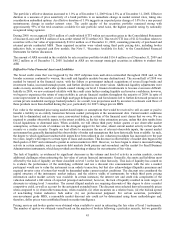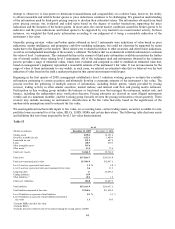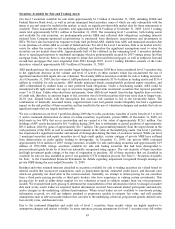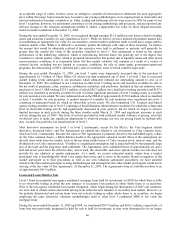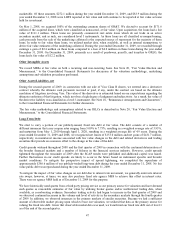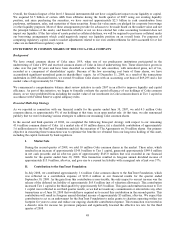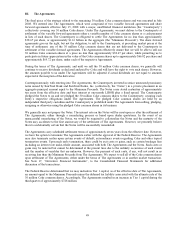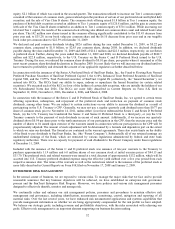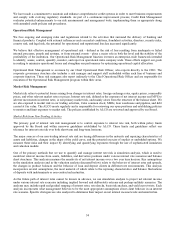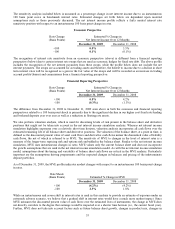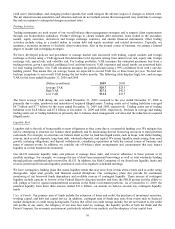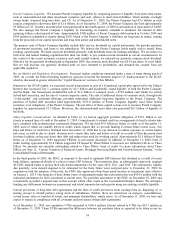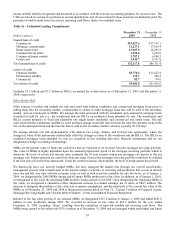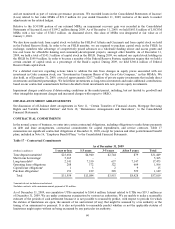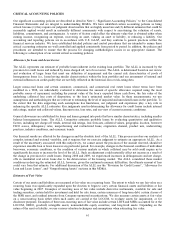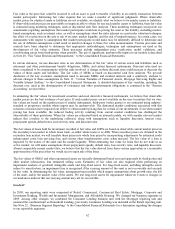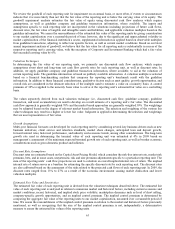SunTrust 2009 Annual Report Download - page 69
Download and view the complete annual report
Please find page 69 of the 2009 SunTrust annual report below. You can navigate through the pages in the report by either clicking on the pages listed below, or by using the keyword search tool below to find specific information within the annual report.Corporate Risk Management’s focus is on synthesizing, assessing, reporting and mitigating the full set of risks at the
enterprise level, and providing senior management with a holistic picture of the organization’s risk profile. We have
implemented an enterprise risk management framework that has improved our ability to manage our aggregate risk profile.
At the core of the framework is our risk vision and risk mission.
Risk Vision: To deliver sophisticated risk management capabilities that are consistent with those of
top-tier financial institutions and that support the needs of SunTrust business units.
Risk Mission: To measure, monitor and manage risk throughout SunTrust to ensure that risk at the
transaction, portfolio and institution levels is viewed consistently in order to optimize risk-adjusted
return decision making.
The Board of Directors is wholly responsible for oversight of our corporate risk governance process. The Risk Committee of
the Board assists the Board of Directors in executing this responsibility.
The CRO reports to the Chief Executive Officer and is responsible for the oversight of the Corporate Risk Management
organization as well as the risk governance processes. The CRO provides overall leadership, vision and direction for our
enterprise risk management framework. In addition, the CRO provides regular risk assessments to the Risk Committee of the
Board and to the full Board of Directors, and provides other information to Executive Management and the Board, as
requested.
The risk governance framework incorporates a variety of senior management risk-related committees. These committees are
responsible for ensuring effective risk measurement and management in their respective areas of authority. These committees
include: CRC, ALCO, PRAC, and the SunTrust Enterprise Risk Program Steering Committee. The CRC is chaired by the
CRO and supports the CRO in measuring and managing our aggregate risk profile. The CRC consists of various senior
executives and meets on a monthly basis.
Organizationally, we measure and oversee risk according to the three traditional risk disciplines of credit risk, market risk
(including liquidity risk) and operational risk (including compliance risk). Credit risk programs are overseen by the Chief
Wholesale Credit Officer and the Chief Retail Credit Officer. Market risk programs are overseen by the Chief Market Risk
Officer. Operational risk programs are overseen by the Chief Operational Risk Officer. The three risk disciplines are
overseen on a consolidated basis under our enterprise risk management framework, which also takes into consideration legal
and reputation risk factors.
The SunTrust Enterprise Risk Program continues to ensure that the approach and plans for risk management are aligned to
the vision and mission of Corporate Risk Management. In addition, the SunTrust Enterprise Risk Program’s goal is to ensure
our future compliance with the Basel II Capital Accord. Key objectives of the SunTrust Enterprise Risk Program include
incorporating risk management principles that encompass our values and standards and that are designed to guide risk-taking
activity, maximizing performance through the balance of risk and reward and leveraging initiatives driven by regulatory
requirements to deliver capabilities to better measure and manage risk.
Credit Risk Management
Credit risk refers to the potential for economic loss arising from the failure of clients to meet their contractual agreements on
all credit instruments, including on-balance sheet exposures from loans and leases, investment securities, contingent
exposures from unfunded commitments, letters of credit, credit derivatives, and counterparty risk under derivative products.
As credit risk is an essential component of many of the products and services we provide to our clients, the ability to
accurately measure and manage credit risk is integral to maintain both the long-run profitability of our lines of business and
our capital adequacy.
The Credit Risk Management group manages and monitors extensions of credit risk through initial underwriting processes
and periodic reviews which then maintain underwriting standards in accordance with credit policies and procedures. The
Corporate Risk Review unit conducts independent risk reviews to ensure active compliance with all policies and procedures.
Credit Risk Management periodically reviews our lines of business to monitor asset quality trends and the appropriateness of
credit policies. In addition, total borrower exposure limits are established and concentration risk is monitored. Credit risk is
partially mitigated through purchase of credit loss protection via third party insurance and use of credit derivatives such as
credit default swaps.
Borrower/counterparty (obligor) risk and facility risk are evaluated using our risk rating methodology, which has been
implemented in all lines of business. We use various risk models in the estimation of expected and unexpected losses. These
models incorporate both internal and external default and loss experience. To the extent possible, we collect internal data to
ensure the validity, reliability, and accuracy of our risk models used in default and loss estimation.
53


